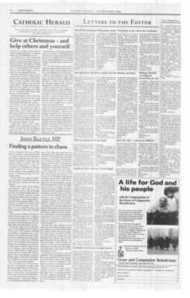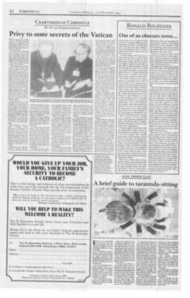Page 5, 2nd December 1994
Page 5

Report an error
Noticed an error on this page?If you've noticed an error in this article please click here to report it.
Tags
Share
Related articles
Justice System Hauled Over The Coals
Guilty Journalists On Trial
Guilty Until Proven Innocents Why The Injustice Continues
But They Don't Have Show _ Trials In Britain, Do They?
The Church And The Prisoner
Miscarriages of justice continue
Lord Justice Simon Brown ruled this week that the Home Office had acted unfairly in not disclosing documents on which it had based its decisions. Paul Donovan reports.
THE RECENT JUDICIAL review of Kenneth Clarke's decision not to refer the case of the Bridgewater Four to the Court of Appeal has revealed some of the inner workings of the Home Office.
The case also reveals an area of the law in urgent need of reform.
During his 15-month tenure at the Home Office Mr Clarke used his powers, under section 17 of the Criminal Appeal Act 1968 to refer back just one case to the Court of Appeal. In the 17 months since Michael Howard succeeded Mr Clarke as Home Secretary only one further case has been referred under the act.
In May the murder convictions of first Eddy Browning and then Prem Sivalingham and Sam Kulasingaham were overturned by the Court of Appeal.
In the meantime, C3, the department of the Home Office that deals with these matters, declared that they are examining another 800 potential miscarriages of justice.
In order to explain the reluctance of Messrs Clarke and Howard to refer cases back to the Court of Appeal it is important to remember the state of the criminal justice system in the early 1990s.
Following the exoneration of the Guildford Four, Birmingham Six and numerous -other victims of miscarriages of justice the system was in disarray with confidence at an all time low.
The retirement of Lord Lane from the Court of Appeal and his replacement by Peter Taylor made matters worse for those bent on damage limitation. The Court of Appeal appeared to be
• allowing appeals as a matter of course.
During the 1980s successive Tory Home Secretary's from Leon Brittain to Douglas Hurd had referred cases to the Court of Appeal in the safe knowledge that Lord Lane and his fellow justices would reject the petitions. (The Bridgewater case
suffered this fate in 1989 when referred by Douglas Hurd).
By the time Kenneth Clarke became Home Secretary in April 1992 a Home Office led damage limitation operation was regarded as a priority. Cases had to be stopped from reaching the new "liberal" Court of Appeal.
It was against this background that the Home Secretary began to encroach on the powers of the courts.
Many argue that this latest episode with the Bridgewater case merely highlights how urgent the need is to remove the referral powers from the
Home Secretary and place them with an independent review authority.
However, some fear that the long promised Criminal Cases Review Authority could be something of a Trojan Horse.
Paul May, chair of the Bridgewater Four Campaign and previously that of Birmingham Six, fears that cases will not be dealt with any more expediently and access could be restricted.
"Accountability to Parliament, must be retained. In a country with such stringent secrecy laws, parliamentary questioning remains a vital avenue through which important evidence may be obtained," he told the Catholic Herald.
"Answers to numerous questions tabled by MP Chris Mullin and Sir John Farr proved vital in establishing the innocence of the Birmingham Six."
A number of lawyers see the creation of such an unaccountable body as unlikely to expedite justice but enabling the Home Secretary to adopt "a nothing to do with me" stance regarding miscarriages of justice.
A salutary lesson can be drawn from the recent campaign against the Child Support Agency. The anger of campaigners was directed toward the nominal head of the agency who eventually lost her job.
Peter Lilley, the politician responsible, escaped relatively unscathed and remains in office.
The desire of the Home Office to insulate itself in this area becomes clear in the discussion paper issued earlier this year on the Criminal Cases Review Authority.
The paper declares that the Home Secretary's sole responsibility for the new authority will involve his presenting an annual report to Parliament.
In addition buried in sections 74 and 75 of the document is the recommendation that the decisions of the Review Authority should not be subject to judicial review.
Whilst the judicial review of the Bridgewater case has shown the Executive abusing state power, Jimmy Robinson, Vincent and Michael Hickey still remain in prison awaiting justice.
The present system has been proved fatally flawed, the Home Secretary it seems in appearing to be seeking a solution may in reality be trying to bury the plight of the innocent beneath another unaccountable bureaucratic quango.
Perhaps, as some lawyers have suggested, the Government should consider splitting the Home Office functions along European lines, creating separate departments of justice and interior.
The present arrangements need to change, but accountability must be retained if not strengthened.
JOHN KINSELLA, A 49-year-old Irishman, has been living in England for over 30 years. He is married to Audrey, a Nottingham woman, and has five children. For a number of years John Kinsella was involved in petty crime.
Some years ago John's nephew, Denis Kinsella, arrived from Ireland and lived with the Kinsella family in Nottingham until he found his own accommodation. John Kinsella was unaware that his nephew held any particular political affiliations.
On February 25 1993 John went to see Denis Kinsella at his flat. Pairac MacFhloinn and Michael Tirnmens were introduced as burglars from Dublin. John was asked if he could store a bag containing the proceeds of a recent crime whilst a "fence" was found. John Kinsella took the bag and buried it on his allotment.
It was MacFhloinn, Timmins and Denis Kinsella who were to carry out the bombing of the Warrington gasworks. Following the explosion there was a chase down the M62 when MacFhloinn fired shots at the police. Denis Kinsella and Pairac MacFhloinn were captured, Michael Timmins escaped.
On February 26 1993 John Kinsella and his wife Audrey were arrested under the Prevention of Terrorism Act. Audrey was released after four days.
It was at this time of John Kinsella's own volition that he led the police to the allotment where the bag was buried. The bag contained semtex explosive, detonators and a sawn off shot gun.
Whilst on remand in Belmarsh prison in London John Kinsella got into such a state of depression that he attempted to slit his own throat with the lid of a tin of salmon. According to Audrey, the wound needed 18 stitches and left a five inch scar.
It was later whilst searching the Kinsella house that the police discovered a photograph of John Kinsella's son standing before the plaque of an IRA volunteer killed by the security forces in the 1970's. The picture had been taken nine years earlier at the Belfast house of a relative of Hugh Scullion with whom John and his son were travelling at the time. The picture showed John's son posing beneath the picture of the volunteer who had been killed.
At the February trial Kinsella's defence argued throughout that he had no links with the IRA, whilst the prosecution sought to use the photographs to rebut this assertion.
The trial judge, Mr Justice McCullough, agreed that the photographs could register as evidence and go before the jury.
Pairic Fhloinn was jailed for 35 years and Denis Kisella for 25 years. John Kinsella was convicted by a 102 majority of possessing explosives with intent and jailed for 20 years.
Last week John Kinsella's case wentto the Appeal Court. Barrister Helena Kennedy QC and solicitor Ron Birkett are confident that the conviction will be overturned. In the Appeal papers the defence argue: "The photographs were of no probative value to the central issue of whether John Kinsella knew that the bag he took control of and buried contained explosives. . The photographs were highly prejudicial because they allowed the jury to speculate as to whether or not John Kinsella was an IRA supporter."
The appeal case was strengthened in April by the decision of the court in the case of R. v Hayes and Taylor. In the latter case, in similar circumstances, the judge ruled that the photographs' "prejudicial effect outweighed their probative value" and so were inadmissible to the jury. The defence also claim that the photographs should have been
excluded under section 78 of the Police and Criminal Evidence Act.
Alan Simpson, Labour MP for Nottingham South, has written to the Lord Chancellor after an approach from John Kinsella's wife Audrey. Paddy Loftus is spearheading the campaign for the release of John Kinsella. Loftus appeared as a witness at John Kinsella's trial and the first question he was asked was whether he was Irish.
Another dimension of the Kinsella case relates to the Criminal Justice Bill. What happened to John Kinsella regarding the photographic evidence demonstrates how potentially dangerous the new anti-terrorist laws enshrined in the Criminal Justice Bill could prove for innocent people.
The new charge of gathering information for terrorist purpose, had it been law, could quite easily have placed John Kinsella in an even more difficult position than that in which he finds himself today. The fact that the PTA has been enhanced at a time when peace talks in Northern Ireland are commencing raises a number of questions regarding the motivation behind this legislation.
John Kinsella is but the latest unfortunate individual to fall victim to this pernicious legislation.
blog comments powered by Disqus













